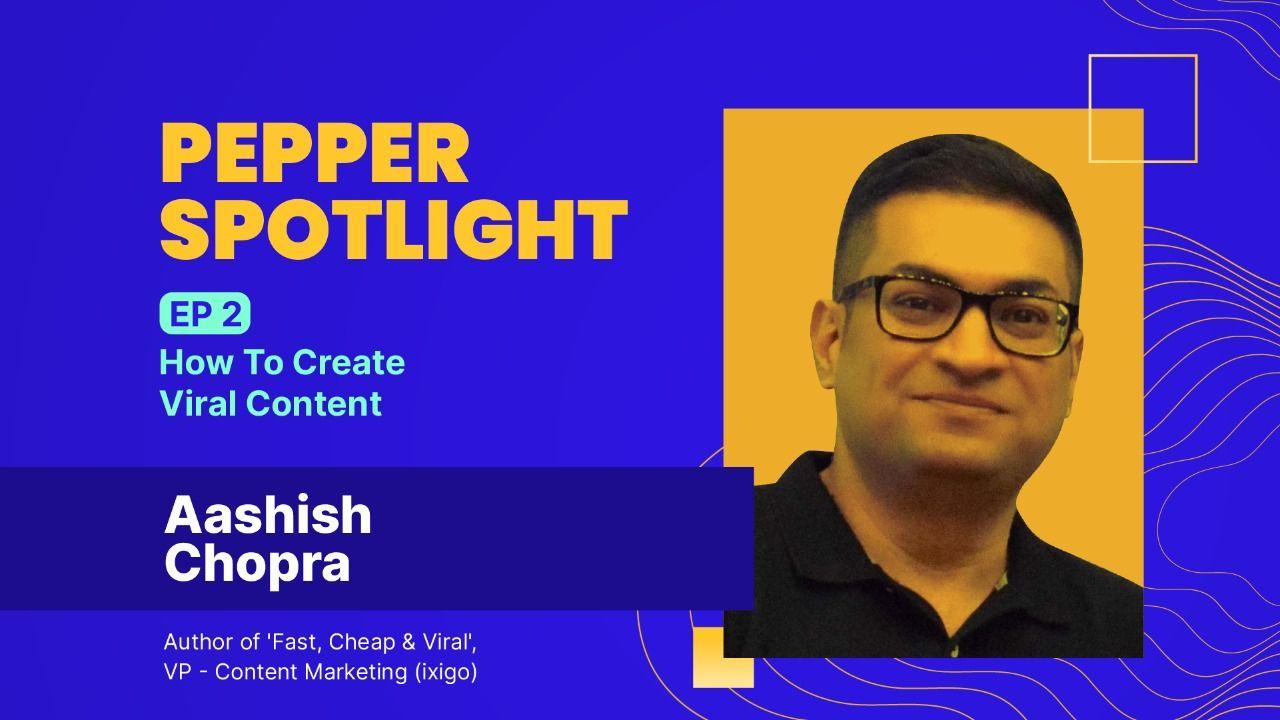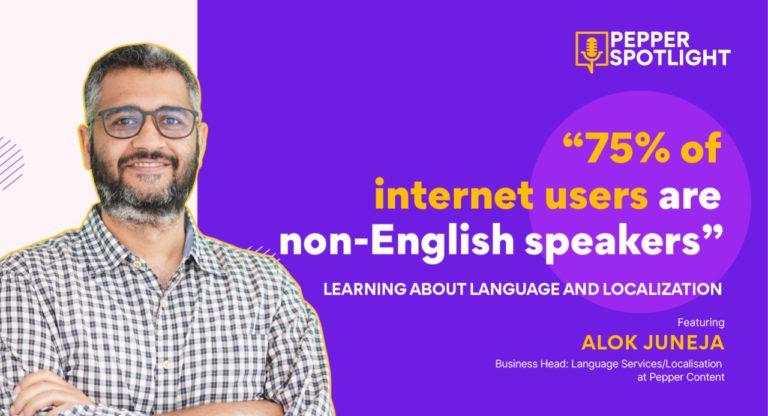Pepper Spotlight | Ep 2: How To Create Viral Content ft Aashish Chopra

About the author
Aashish Chopra is a seasoned marketing communications maverick. Aashish has built a reputation for being the spot on guy for years. He has partnered with both established and emerging brands to guide content creation and curation. A much sought-after author of the bestselling book “Fast, Cheap and Viral”, he’s the creative force behind many viral campaigns and videos. By helping academic organisations like NIIT set up a new certificate program and by serving as a faculty member, Aashish has been at the helm of content marketing. He has served on prestigious award juries and is currently on the advisory board of DMAAsia.
Here’s an excerpt from his chat with Pawan Rochwani for the Pepper Spotlight Podcast series.
How do you gauge the virality of a content piece?
When it comes to zeroing down on a content piece’s possible virality, the only thing that matters is share worthiness and engagement. Once a brand is conscious about creating content about users and not just the branding requirements, the content has a high likelihood of hitting the viral zone.
And lastly, the content should ideally fall into one or overlap across more of the 5 tried and tested categories that content falls in
- Inspirational content
- Usefulness to the user/audience
- Content that celebrates the user’s life
- Topical content
- Content that attempts to make the world a better place
Why is the attention span so important to both short and long form content?
Content creation and consumption have grown exponentially over the last few years.
Now the users see the content providers as either destination platforms like Netflix and OTT channels or the hangout platforms in social media like Facebook, Instagram, Twitter, etc.
Owing to a lack of relatable content earlier and the massive multiplication of content available now, ad fatigue has also grown on a considerable scale. We’re even programmed to adjust our vision to avoid, like how we go to a website and mask out ads automatically.
So, that’s why the initial hook is integral to building and retaining the user’s attention.
Has short form content created a directional shift in content consumption, spurred by the rise of Insta reels, Youtube shorts?
With the easy accessibility of cheap smartphones and 4G networks, there has been an explosion of ephemeral content. This has democratized the creation process and led to the opening of the floodgates of content volume.
But now, all the users are busy scrolling more and more, looking for snackable video stories and the whole aim of content creators is to fight the swiping thumb. The user’s media consumption behavior decides the need for a shorter content format. Short form content fits the sporadic usage of these hangout platforms. And, yes, no doubt long form content has its space, but short form content has higher ROI throughout the day.
How important is user observation, are you always driven by authenticity in the content planning process by relying on exhaustive user research?
Authenticity is the very nature of the content. Earlier, we’re exposed to scripted content, but now what you see is what you get. The audience has evolved in consumption behavior.
I always recommend focusing on the customer’s pain points to pinpoint the direction of your brand’s communication plans. This user research is a goldmine of content ideas. Brands should always first walk in the shoes of the target audience. By aligning with the user journey and addressing their pain points, the content is tailor-made for consumption. And lastly, It is not sheer hard sell that works, and brands have to grab an opportunity and create the potential for plugging their offering to the audience.
Should brands consider segregating content into buckets for branding and core user concerns?
The main thumb rule here is, brand integration should be native to the narrative. The guiding light of content planning is to make it as user centric as possible. We should always take a deep dive into the user’s daily lives. And monitor all the granular details like what is the most popular smartphone screen size being used at large?
During brainstorming sessions, preserving the sanctity of one wow moment should be maintained and executed well. There should be no forced plug. Branding content should smoothly complement with customer journey.
It is said that content marketing is the opposite of advertising, what do you say about that?
The important fact to consider here is the narrowing attention span of a user over the past decade. It all changed with the introduction of a bullshit detector or the TV remote.
An average Indian nowadays spends 48 hours per week on smartphones, tablets, and computers and watches for 4 hours a week. With this, our ad alert has highly evolved. That’s why planning content for digital channels in comparison to TV advertising production is vastly different. Like TVCs, brands have to hit every ball for a six, whereas you can achieve the same traction with two viral pieces from a campaign of 10 assets. Hence, digital content should be paid attention to, both with budgets and volume.
What has been the lasting effect on content creation due to new user growth aided by readily available smartphones and the internet, coupled with Covid 19 forced lockdowns? What’s been the significant impact and emerging trends in this perspective?
There was a dearth of advertorial communication due to the sheer panic going around public life. The only thing getting eyeballs was organic content. I will say that the pandemic ushered in the golden age of content.
For brands, the challenge was to be relevant, even when conversations were beyond their content plan. So that’s why one of the lasting effects was for brands to create crisp and to the point communication, cutting to the chase.
How different is the process of creating branded content vs writing about the branded content personally?
Content creation ultimately boils down to consistency. Like, how regularly you can create content to be visible. It is all about progress and not chasing perfection. This is inherent to creating branded communication. Whereas writing for the book is like dedicating every weekend for 2-3 years to arrive at a finished product ultimately.
Is perfectionism overrated? Is it overly romanticized?
Perfectionism might be the most negative thing to happen to the creative process besides laziness. Perfectionism creates unnecessary delays. It would help if you defined your minimum viable excellence needed in your communication and then adhere to it without fretting about making it perfect. Because the more you seek perfection, the more you procrastinate, and more so, the Intent to execute the project decreases.
How do you see the future of content space entirely?
Regional content is the next hot spot for every brand and content marketer.
There is huge scope to reimagine influencer marketing, apart from looking at them as distribution channels. It is following a steady format for some time now.
Podcasts also rose
When Covid19 hit the world, people got more personal time in lockdowns. This led to a tectonic shift arising out of user behavior. There is a lot of potential in audio content now and in the future.
How will the video space be in the next few years?
There is a vast scope for brands and content creators to experiment with formats in video marketing. For example, live videos are not the focus of anyone right now.
Will regional content get the spotlight of branded initiatives?
One viral piece can easily transcend the original target audience. As brands, we have to speak the target audience’s language. And once users can relate to the branded communication, the possibility of the word of mouth rises.
It is relatively easy to create content and distribute, and naturally, every company will become a content company. What does the future look like to you?
The only brands that will get to the top will be the ones who are aligned with the user’s journey. Being a content creator is like running a marathon. By figuring out directions and then leveraging these creation and distribution tools, brands can streamline the content process that ticks all the boxes.
Lastly, we have a fun round of questions. Would you rather create more videos or host and organize more webinars?
Definitely more videos any day. Because with videos, you will have the advantage of longevity, and these will be easily accessible by the target audience compared to the limited reach of webinars.
Would you rather have a higher CTR or get more shares?
Since shares have a snowball effect on all parameters, so I definitely will prefer shares.
It is like, shares are the kind of tides, which raises all the boats.
Would you rather be a part of a big tea set up or work in a smaller setup?
With smaller teams, you can attain a focused approach to working together. Smaller teams are like Ninjas that can collaborate smoothly. And larger teams have many moving parts, so I would always prefer working in smaller teams.
To listen to the full conversation with Aashish Chopra tune in to Pepper Spotlight (https://spotlight.peppercontent.in).

Latest Blogs
Explore how Google’s 2025 AI search updates triggered ranking chaos. Learn actionable strategies to adapt your SEO for AI Overviews, zero-click searches, and SERP volatility. Stay ahead now.
Learn how to rank on AI search engines like ChatGPT, Perplexity, and Gemini by optimizing your content for authority, structure, and relevance. Stay ahead in AI-driven search with this strategic guide.
Explore the best healthcare SEO services for your medical practice. Improve online visibility and effectively reach more patients in need of your services.
Get your hands on the latest news!
Similar Posts

Pepper SPOTLIGHT
3 mins read
Learning About Language and Localization Podcast with Alok Juneja: Pepper Spotlight

Content
7 mins read
What Marie Kondo Can Teach You About Writing Better

Email Marketing
8 mins read